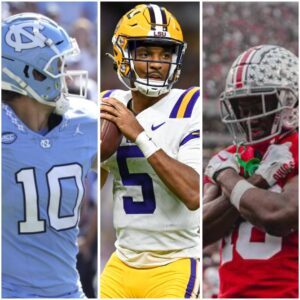With the grand stage of the Super Bowl long gone, football enthusiasts worldwide eagerly await the return of football. However, the journey to the pinnacle of the NFL was fraught with challenges, as seen by the fate of the twelve teams that battled through the playoffs only to fall short of the ultimate goal. Each elimination holds a story of resilience, strategic maneuvers, and the unpredictable twists that characterize the sport. As we get further away from the conclusion of the big dance, let’s rewind and dissect the X-factor that led to the elimination of these teams, shedding light on the defining moments and factors that shaped their postseason destinies.
The Cleveland Browns: Injury
The Cleveland Browns faced a formidable challenge in their recent wild-card matchup against the Houston Texans, ultimately succumbing to the relentless defensive pressure and offensive explosion of CJ Stroud. Plagued by a string of injuries, the Browns found themselves fielding a lineup dotted with third and fourth-string players. While the game provided spectators with the excitement of witnessing Joe Flacco leading a captivating Cinderella story throughout the final weeks of the regular season, the fairy tale came to an abrupt end. The clock struck midnight on the Browns’ season, as they battled bravely but were ultimately overpowered by the youthful and feisty Houston Texans.
The Miami Dolphins: Offensive playcalling + Tua Tagovailoa
In their matchup against the Kansas City Chiefs, the Miami Dolphins lost in an embarrassing defeat. Quarterback Tua Tagovailoa’s performance struggled to meet the demands of the harsh conditions with a -30-degree windchill. Tua’s accuracy, in particular, was sub-par, hindering his ability to connect with receivers effectively. However, the issues extended beyond the quarterback, as the offensive playcalling compounded the Dolphins’ woes. In critical situations, the game plan relied heavily on screens, check-downs, and short passes, providing the Chiefs’ defense ample opportunities to anticipate and defend against the predictable plays. This loss has provided fodder for critics of the Dolphins, who argue that the team’s success this season was a result of navigating a relatively softer schedule. With only one victory against a team boasting a winning percentage above .500, skeptics may point to this defeat as evidence that the Dolphins faced challenges when pitted against more formidable opponents.
Dallas Cowboys: Defensive Collapse + Dak Prescott
The Dallas Cowboys faced a stunning collapse in their matchup against the Green Bay Packers, leaving fans and analysts alike in disbelief. Quarterback Dak Prescott, who has been a key architect of the Cowboys’ offensive prowess, encountered significant struggles throughout the game, particularly in connecting with standout receiver CeeDee Lamb. The turning point came in the second quarter when Prescott threw a costly pick-six, adding to the mounting challenges for the Cowboys. On the defensive front, the Cowboys couldn’t find an answer to Green Bay’s Jordan Love, who orchestrated a formidable offensive display, resulting in a staggering 48 points for the Packers. Despite a late-game surge by the Cowboys, attempting to regain momentum, it proved to be too little, too late against the dominant performance of the Green Bay Packers.
The LA Rams: Red-zone Efficiency
Against the Detroit Lions, the youthful Los Angeles Rams showcased the promise of their emerging talent, particularly in the standout performance of rookie wideout Puka Nacua. Making a stellar playoff debut, Nacua amassed an impressive 181 yards and secured a crucial touchdown. Despite these individual achievements, the Rams faced a challenge in the second half, notably in the red zone. The Rams found themselves in scoring positions four times, yet their red zone efficiency waned, and they could only settle for field goals. This inability to convert opportunities into touchdowns proved to be a decisive factor, highlighting the resilience of the Lions’ defense, which bent but did not break. Ultimately, the Lions capitalized on the Rams’ scoring struggles, securing a narrow victory by a single point.
The Pittsburgh Steelers: Broderick Jones
In their playoff clash against the Buffalo Bills, the Pittsburgh Steelers faced a significant hurdle that ultimately tilted the game in favor of their opponents. The pivotal X factor emerged in the form of the Steelers’ offensive line, particularly Broderick Jones. Struggling against the formidable defensive front of the Bills, Jones experienced difficulties, allowing a sack, four hurries, and five pressures. The collective performance of the rest of the offensive line mirrored this subpar showing. The relentless pressure from the Bills’ defense disrupted the rhythm of quarterback Mason Rudolph, preventing him from finding comfort in the pocket. This offensive line vulnerability proved to be a decisive factor, allowing the Bills’ defense to dictate the pace and emerge victorious against the Steelers.
The Philadelphia Eagles: Defensive Tackling
The Philadelphia Eagles, once standing tall at an impressive 10-1 record, experienced a surprising late-season downturn that altered their postseason trajectory. The anticipation of an NFC representation in the Super Bowl turned into a stark reality check as they stumbled, losing six of their last seven games. In a crucial matchup against the Tampa Bay Buccaneers, the Eagles’ vulnerabilities were laid bare, particularly in defensive tackling and coverage. Baker Mayfield, at the helm for the Buccaneers, exploited soft coverage, and Tampa’s receivers easily evaded multiple tackles, transforming routine plays into long gains and touchdowns. This defensive struggle, coupled with a lackluster offensive production, ultimately marked the end of the Eagles’ season, leaving them falling short of the lofty expectations set earlier in the year.
The Houston Texans: Inexperience
The Houston Texans went in their playoff matchup against the Baltimore Ravens, resulting in a tough defeat. Rookie quarterback CJ Stroud, tasked with leading the offense, struggled to generate momentum, and a resilient Baltimore defense held the Texans to a lone field goal, while a touchdown was notched on special teams. The Texans’ defense showcased determination in the first half, holding their own against the Ravens. However, the seasoned Ravens offense found the necessary breakthrough in the second half, securing the win. Despite the playoff loss, the Texans, a notably young team with limited postseason experience, can take pride in exceeding preseason expectations. Their journey, though cut short in the playoffs, signals a promising future and underscores the growth of a team that defied initial predictions.
The Green Bay Packers: Anders Carlson
The Green Bay Packers’ journey in the divisional round took an unexpected turn as they faced a narrow defeat against the San Francisco 49ers, with a pivotal moment centering around kicker Anders Carlson. Amid stormy conditions, Carlson found himself in a challenging situation, missing a crucial field goal halfway through the fourth quarter. While it’s undeniably tough to place blame solely on the kicker, the miss had significant consequences. The 49ers seized the opportunity presented by a short field and managed to score the go-ahead touchdown. The pressure escalated for quarterback Jordan Love, who, with less than two minutes remaining, aimed to tie the game. Unfortunately, his efforts resulted in a costly interception, sealing the fate of the Packers in a hard-fought contest that highlighted the unpredictable nature of postseason football.
The Tampa Bay Buccaneers: Baker Mayfield
In a closely contested matchup against the Detroit Lions, the Tampa Bay Buccaneers faced a disappointing outcome, with the pivotal moment unfolding in the final drive. Quarterback Baker Mayfield faced a critical juncture and unfortunately threw a crucial interception, marking his second of the day. This raised questions about Mayfield’s clutch performance, as the signal-caller is yet to consistently prove his reliability in high-pressure moments outside of a notable game last season. While there is acknowledgment of his deserving a significant contract in the upcoming offseason, Mayfield faces the challenge of demonstrating that he can be the go-to player when the game is on the line, especially in crucial moments down the stretch. The interception on the final drive served as a stark reminder of the need for Mayfield to cement his reputation as a clutch performer.
The Buffalo Bills: Fate
In a third meeting within four years, the Buffalo Bills found themselves once again pitted against the Kansas City Chiefs. However, mirroring the outcomes of the two previous encounters, the Chiefs emerged victorious. The Bills faced setbacks, primarily attributed to quarterback Josh Allen’s struggles to connect with his receivers in critical moments, thanks to the relentless defense deployed by the Chiefs. The Bills’ defense, which held its ground in the first half, appeared vulnerable in the latter part of the game. The turning point came in the final minutes when Tyler Bass, the Bills’ reliable kicker, missed a field goal that could have propelled them into the lead. This missed opportunity proved to be the key moment, as the Chiefs seized control and secured the win, leaving the Bills to ponder what might have been in a closely contested matchup.
The Baltimore Ravens: Offensive gameplan
The AFC Championship clash between the Baltimore Ravens and the Kansas City Chiefs ended in a disappointing loss for the Ravens, sparking scrutiny, particularly in the realm of offensive playcalling. Despite the Chiefs’ perceived vulnerability against the run, the Ravens curiously opted for just 18 rushing attempts in the game. While certain decisions by Zay Flowers, including a costly taunting penalty and a fumble at the goal line, drew attention, the larger concern lay in the struggle of the Ravens’ offense to make headway. This struggle was exemplified by Lamar Jackson’s interception into triple coverage, highlighting a recurring question about his postseason success. The Chiefs’ defense, often seen as weaker against the run, presented an opportunity that the Ravens failed to fully exploit, leaving critics to question the strategic choices made by the coaching staff in a pivotal game that ultimately slipped through their grasp.
The Detroit Lions: Overagression
Throughout the season, the Detroit Lions’ fortunes often hinged on their aggressive style of play. However, in a crucial matchup against the San Francisco 49ers, their overaggression became a double-edged sword. Holding a commanding 24-7 lead deep in 49ers territory in the 3rd quarter, the Lions surprised many by ignoring the field goal option, a decision that ultimately proved unsuccessful. The opportunity presented itself again later in the game, with the chance to tie with a longer field goal, but once more, the Lions opted for an aggressive approach. Unfortunately, they fell short, and the repercussions were felt as they lost the game by a narrow margin of three points. The fine line between success and defeat for the Lions, who lived and died by their aggressive strategy throughout the year, showcased the high stakes and inherent risks associated with their bold approach.
Credit to John Bloomer as a co-author.






